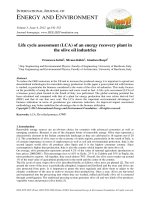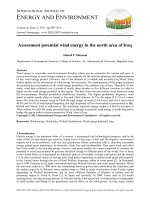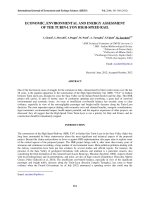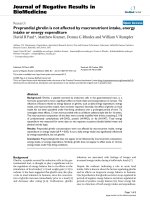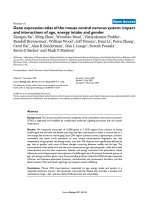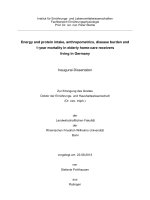04 energy intake assessment 2
Bạn đang xem bản rút gọn của tài liệu. Xem và tải ngay bản đầy đủ của tài liệu tại đây (528.67 KB, 12 trang )
UNIVERSITY
Energy
Intake
Assessment
Starting from a place of
maintenance
The Lesson
•TDEE (total daily energy expenditure)
•Why Maintain?
•Tracking Your Food Intake
•Finding Maintenance Calories
•Estimating Maintenance Calories
•Tracking NEAT
•Tracking Cardio and Resistance Training
•Know your Energy Intake and Output
Components of TDEE
Total Daily Energy Expenditure
BMR
5%
NEAT
10%
TEF
15%
TEA
70%
Why Know Your Maintenance
TDEE?
•Manipulate Body Composition Accurately
•Time Oriented Goals
•Understand Body Homeostasis
•Understand Adaptative Thermogenesis
Tracking Foods For Energy and
Macro Intake
•Accuracy, Consistency, Flexibility, Adherence
•Strict Meal Plans
•Macros
•Food Avoidance
•Food tracking Applications: MyFitnessPal App
•Excel Spreadsheets (see attached)
Measuring Foods
LETS HEAD TO THE KITCHEN!
Finding Your Maintenance
•Track Calories and macros for 2 weeks and
calculate you daily average
•Track body weight for 2 weeks
•Subtract the week 1 average from the
week 2 average
•This will tell you if you are gaining and
losing weight
•1lb = 3500kcal, multiply your weight
difference by 3500 and divide by 7 days
per week to get you daily surplus or deficit
you are in.
•Add this amount to your daily calorie
average and you get maintenance calories
Tracking Based Calculation
Sample Math:
• I lost 0.8lbs over one week, which is
equivalent to 2800kcal (0.8 x 3500kcal)
• 2800kcal divided by 7 days per week =
400kcal
• My daily average calorie intake for the 14
days was 2300kcal
• To get maintenance: 400kcal +2300kcal =
2700kcal
Quick Maintenance Calorie
Estimation
•BMR= 10 x body weight (lbs)
•Example: 10 x 200lbs = 2000kcal
•Multiple BMR x Activity Factor
ACTIVITY
LIFESTYLE & TRAINING FREQUENCY FACTOR
Sedentary plus 3-6 days of weight lifting 1.3 – 1.6
Lightly active plus 3-6 days of weight
1.5 – 1.8
lifting
Active plus 3-6 days of weight lifting
1.7 – 2.0
Very active plus 3-6 days of weight
1.9 – 2.2
lifting
• 2000Kcal x 1.3 = 2600kcal
Tracking NEAT
•Non Exercise Activity Thermogenesis
•Largest variable factor depending on activity
level (200-2000kcal)
•Steps Counter (pedometer) Cost effective
and easy
•2000 steps = ~1mile = ~100kcal
•Tool to manipulate energy expenditure
•Monitor for decreased expenditure
Energy Expenditure Cardio and
Resistance Training
•Track Heart Rate During Cardio
• />•Know your calorie expenditure per minute
•Resistance Training Tracking
Your Physique Data
• TDEE
• You should know your
calorie intake, macros,
step count and heart
rate during cardio
• Ability to manipulate
body weight
• Now adjust towards
your goals
• 3500kcal = 1 pound of
fat
• 2500kcal = 1 pound of
muscle
Baseline
240
5'7"
weight:
height
estimated body
fat
13
total body fat lbs
31
chest
129.5
L arm
60
R arm
59.8
2" above
87.2
At naval
90.2
2" below
92.4
Hips
106.7
L thigh
73.6
R thigh
73.2
caliper glute
9
caliper lower
back
15
weekly wt
change:
0.8lbs
Average Calorie
intake
2300kcal
225c/275
p/40f
Macros:
Step count
3000
Cardio duration 30
Daily average
minutes
